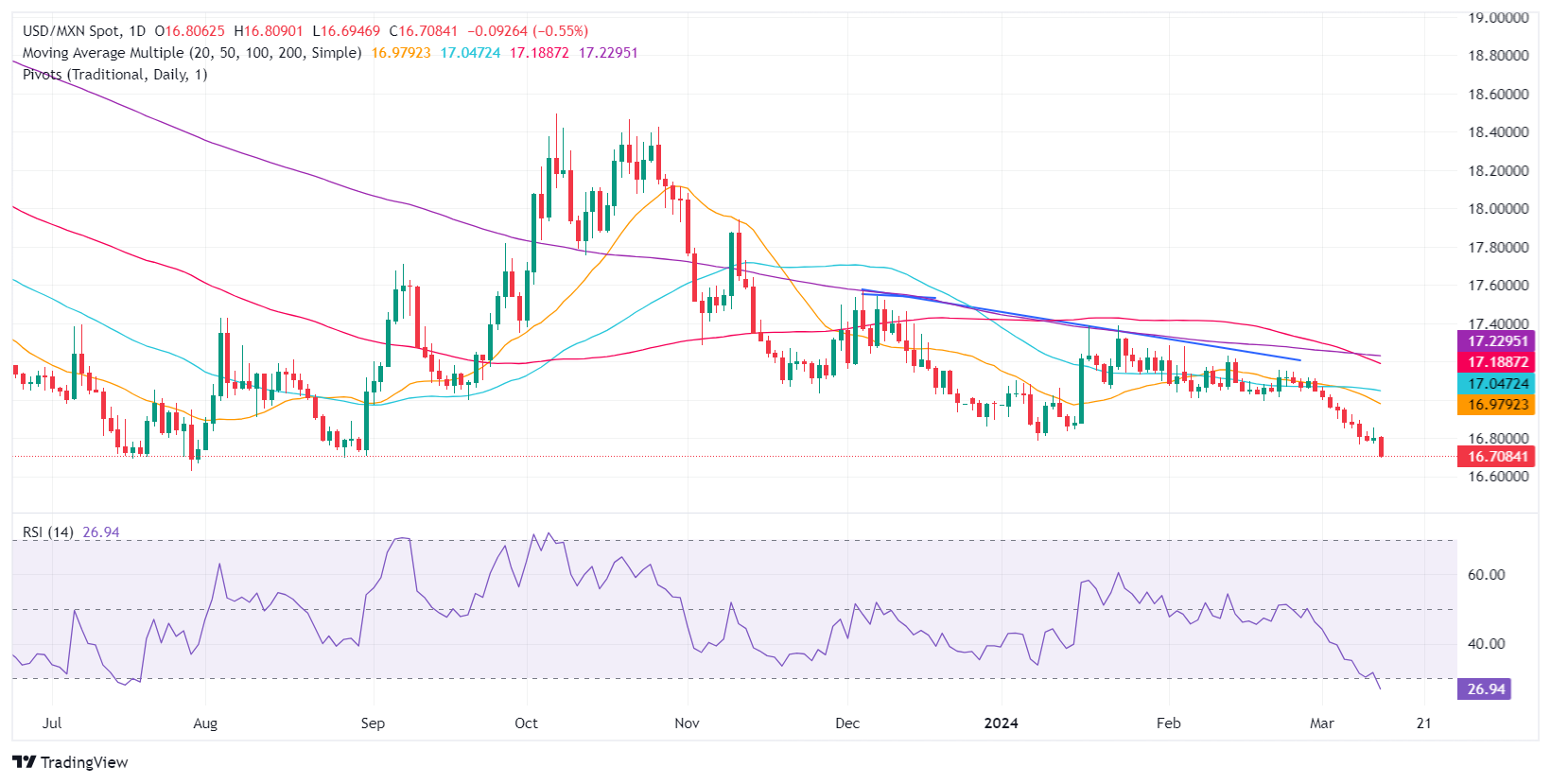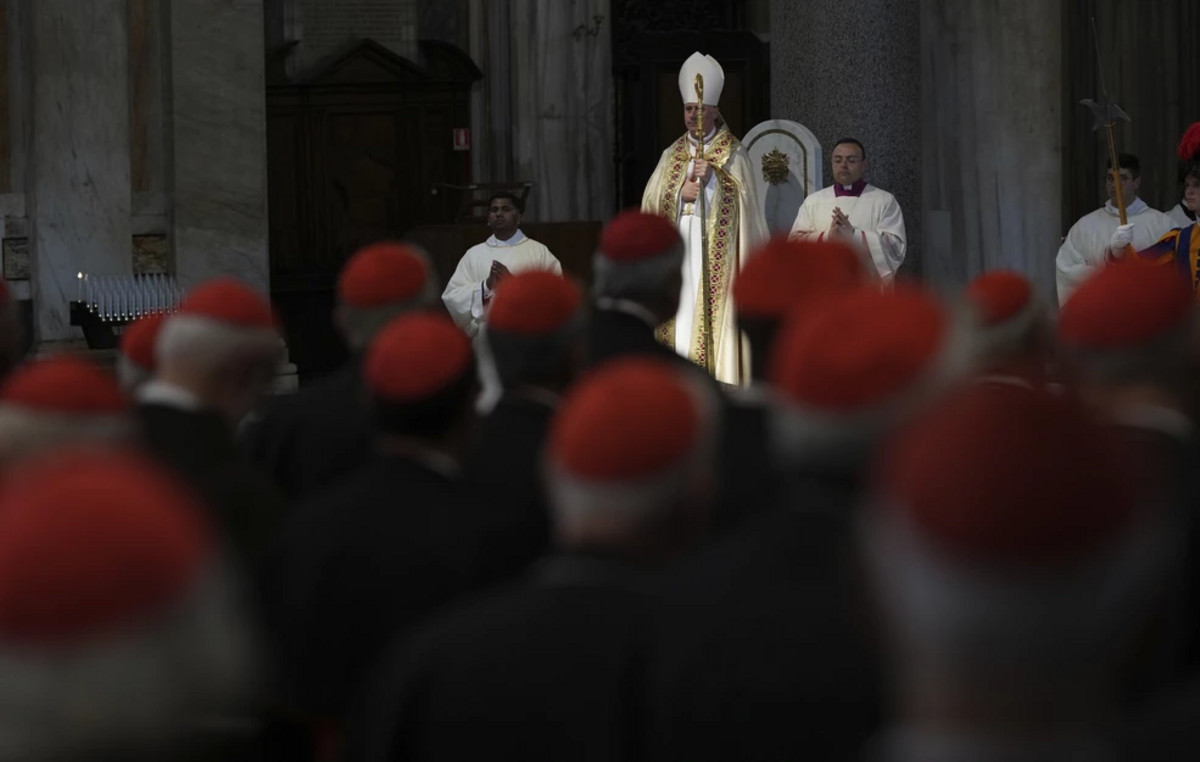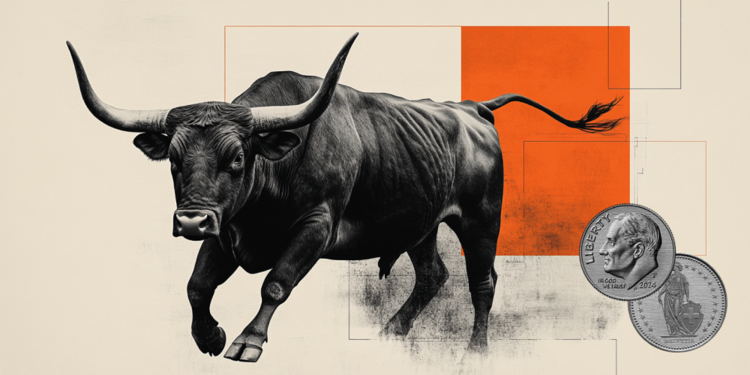- The Mexican peso strengthens and reaches its highest level so far this year.
- Banxico's deputy governor hints at possible rate cuts despite maintaining a restrictive policy.
- Short-term momentum favors the Peso, pushing USD/MXN to new lows despite dovish comments from Banxico.
The Mexican peso recorded a new high so far this year against the US dollar during trading on Wednesday, amid a weak economic program in the United States. Traders downplayed the tepid US inflation report announced on Tuesday, while Mexican industrial production fell in line with estimates. Thus, the USD/MXN pair operates at 16.68, with a drop of 0.68%.
On Mexico's economic agenda, the deputy governor of the Bank of Mexico (Banxico), Omar Mejía, crossed the wires. Mejía stated that it is not premature to consider the possibility of lowering interest rates set at 11.25%, although he warned that future rate cuts must remain restrictive. He added that the challenge going forward is to adjust policy as the disinflation process evolves.
Despite Mejia's dovish comments, the USD/MXN pair extended its losses towards new all-time lows as the pair accelerated below 16.70 during the mid-week session.
Daily summary of market movements: The Mexican peso stands out from the tepid US inflation data
- The National Institute of Statistics (INEGI) revealed that Mexico's industrial production in January rose 0.4% month-on-month, as expected, compared to -0.7% previously. In the twelve months through January, production rose 2.9%, above estimates, shattering December's 0% reading.
- The latest report on the Consumer Price Index (CPI) in the United States justified the Federal Reserve's decision to keep interest rates unchanged, as inflation appears anchored above the 3% threshold. Fed Chairman Jerome Powell and his colleagues said they need more evidence before lowering borrowing costs, adding that they are in no rush. New data is expected, such as the improvement in retail sales, while the Producer Price Index (PPI) will show mixed figures, with 1.9% year-on-year for core inflation, below 2%, and 1.1% year-on-year for general inflation, above 0.9%. The next Fed meeting is scheduled for March 19 and 20.
- Business activity in the US sector segment remained mixed as Factory Orders plummeted. According to the ADP Employment Change report, the labor market cooled further, although private hiring remained strong. The January non-farm payrolls report was revised downwards, causing a reaction in the swaps market.
- A Reuters poll showed investors expect the Fed to be the first central bank to cut rates in June.
- Meanwhile, 52 of 108 economists expect the Fed to cut rates by 75 basis points in 2024, and 26 to do so by 100 basis points.
- According to a Reuters poll, the Mexican peso will depreciate 7% to 18.24 in 12 months, from 16.96 on Monday, according to the median of 20 currency strategists surveyed between March 1 and 4. The forecasts ranged between 3:50 p.m. and 7:00 p.m.
- A Reuters poll shows that 15 analysts estimate inflation will slow in February, corroborating bets that Banxico could cut rates as early as its March 21 meeting.
- The projections of the private survey of Banxico analysts for February were released. They expect inflation of 4.10%, an underlying CPI of 4.06% and economic growth of 2.40%, unchanged from January. Regarding monetary policy, they see Banxico lowering rates to 9.50% and the USD/MXN exchange rate at 18.31, down from 18.50.
- During Banxico's quarterly report, those responsible for monetary policy recognized the progress in inflation and called for caution against premature interest rate cuts. Governor Victoria Rodríguez Ceja said the adjustments would be gradual, while deputy governors Galia Borja and Jonathan Heath urged caution. The latter specifically warned of the risks of a premature rate cut.
- Banxico updated its economic growth forecasts for 2024 from 3.0% to 2.8% year-on-year and maintained 1.5% for 2025. The slowdown is attributed to the increase in interest rates to 11.25%, which caused the change of position of three of the five governors of Banxico, who aim for a first rate cut at the March 21 meeting.
- CME's FedWatch tool shows that traders reduced their bets on a 25 basis point rate cut in June, from 72% a day ago to 64%.
Technical analysis: The Mexican Peso accelerates its recovery and USD/MXN approaches 16.70
The USD/MXN bearish trend is gaining momentum, despite the Relative Strength Index (RSI) showing the pair as oversold. However, due to the strength of the move, traders are looking for oversold RSI readings at 20.00 as the pair dives to test last year's low of 16.62. Once above that level, the next stop would be the October 2015 low at 16.32.
Despite that, they need to reclaim the 17.00 figure, which could open the door to testing the 50-day SMA at 17.04, followed by the confluence of the 200-day SMA and the 100-day SMA. days at 17.23.
USD/MXN Price Action – Daily Chart

Inflation FAQ
What is Inflation?
Inflation measures the rise in prices of a representative basket of goods and services. General inflation is usually expressed as a month-on-month and year-on-year percentage change. Core inflation excludes more volatile items, such as food and fuel, which can fluctuate due to geopolitical and seasonal factors. Core inflation is the figure economists focus on and is the target level of central banks, which are mandated to keep inflation at a manageable level, typically around 2%.
What is the Consumer Price Index (CPI)?
The Consumer Price Index (CPI) measures the variation in prices of a basket of goods and services over a period of time. It is usually expressed as a percentage of inter-monthly and inter-annual variation. Core CPI is the target of central banks as it excludes food and fuel volatility. When the underlying CPI exceeds 2%, interest rates usually rise, and vice versa when it falls below 2%. Since higher interest rates are positive for a currency, higher inflation usually translates into a stronger currency. The opposite occurs when inflation falls.
What is the impact of inflation on currency exchange?
Although it may seem counterintuitive, high inflation in a country drives up the value of its currency and vice versa in the case of lower inflation. This is because the central bank will typically raise interest rates to combat higher inflation, attracting more global capital inflows from investors looking for a lucrative place to park their money.
How does inflation influence the price of Gold?
Gold was once the go-to asset for investors during times of high inflation because it preserved its value, and while investors often continue to purchase gold for its safe haven properties during times of extreme market turmoil, this is not the case. most of the time. This is because when inflation is high, central banks raise interest rates to combat it.
Higher interest rates are negative for Gold because they increase the opportunity cost of holding Gold versus an interest-bearing asset or placing money in a cash deposit account. On the contrary, lower inflation tends to be positive for Gold, as it reduces interest rates, making the shiny metal a more viable investment alternative.
Source: Fx Street
I am Joshua Winder, a senior-level journalist and editor at World Stock Market. I specialize in covering news related to the stock market and economic trends. With more than 8 years of experience in this field, I have become an expert in financial reporting.







